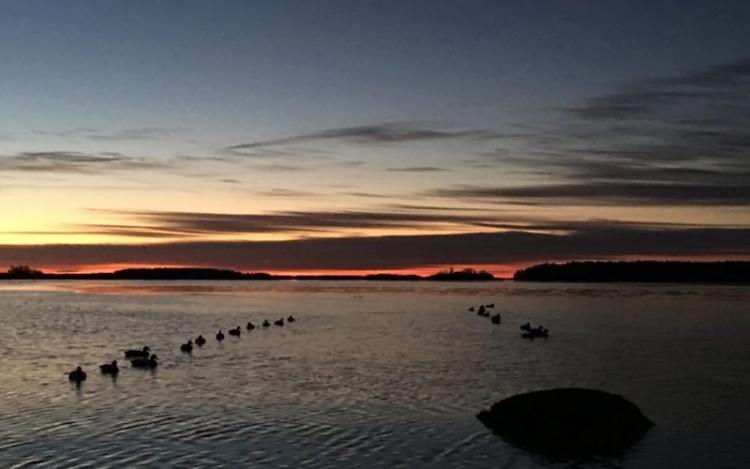Sea duck hunting is a sport of extremes. The action can be hot and prolonged but the temperatures are often cold, as in northern Saskatchewan deer hunting or sub-arctic polar bear hunting cold. Rather than the local marsh or pond, you’re on the open ocean, a proposition that presents its fair share of potential pitfalls even in mild conditions, but especially when winter winds whip waves to a froth. Heavy layers of clothing help fight the cold but significantly restrict movement. It’s a true test of endurance, yet each winter a few bold lads and lassies venture forth. I often wonder why.
For some it may be the challenge, pitting yourself, man against beast, and nature itself. Others enjoy the opportunity for some sporty wingshooting, and there’s often plenty of it when the birds are working. And for many, it’s a trophy hunt, a chance to bring home a beautiful drake eider that will hold a place of honor in the trophy room. But before you book that bucket list hunt, there are a few things you should know about sea duck hunting.
Get an Early Start
You have to start early. The birds fly best at first light but there’s many a mile to go before that. First there’s the ride to the ramp and enough time to load gear and launch. Then you motor out into the vast expanse of open ocean, a process impeded by darkness and often, sea conditions. Hunters and dogs are off-loaded onto islands or tidal ledges, then the laborious process of laying out decoys commences.
Sea Duck Decoy Spread
You need lots of decoys, with three dozen being a modest spread and the more the better.
Unlike puddle duck decoys, which each get their own anchor, sea duck decoys are attached to a mother line with anchors at either end – roughly a dozen or so to a line. The process is much like laying out a longline for swordfish or halibut, which is why longline clips and gangions are a good choice for attaching decoys to the mother line, especially when wearing heavy gloves.
Best Time To Hunt Sea Ducks
Sea ducks can be hunted earlier in the fall but eiders are hardy birds and often the big numbers don’t show up until December or January, when air temperatures can plummet into the teens and even single digits. That calls for extra warm clothes and footwear, and you’re forever toeing a fine line between being warm enough and not being able to move.
Guns and Ammo for Sea Duck Hunting
Guns and ammo can be basically the same as you would use for inland waterfowling, with a few noteworthy exceptions. No form of waterfowling is tougher on guns. They get knocked around in boats and on the rocks and they get splashed, sometimes inundated with highly corrosive salt water. Save the fancy, fine firearms for inland shooting and bring your old beater gun, something that won’t be sorely missed should it find its way to Davy Jones’ locker instead of back to your gun locker.
It should be chambered to hold at least 3-inch shells, with 3-1/2 being a better choice. Those down feathers the eiders are so famous for also make for a fairly effective flak vest and they can take a licking and keep on ticking. Steel sometimes seems to bounce right off so you may want to go with something heavier like bismuth or tungsten shot, and larger shot sizes like 1, F or BB. Knockdown power is more important than pattern density.
You’ll want to bring a lot of loads too. When the birds are working, full bag limits are often the rule rather than the exception, even when hunters practice voluntary restraint and only shoot drakes. As mentioned, the birds are tough and often require a follow-up shot, or two.
Eiders Good Looks
While the black and white eiders may seem a tad bland from a distance, and the all-brown hens drabber still, both are quite handsome in the hand. Over the white, mature drakes sport a chartreuse blush on the back of their neck, a hint of pink on their neck and a spicy brown mustard bill. The dull brown on hens turns to chestnut and black barring on closer inspection, and a pair of eiders makes a better mount than just one.
Eiders for Dinner?
Eiders have a somewhat well-deserved reputation for not being particularly fine table fare, unless you’re one of those odd individuals that happens to like anchovies and liver. There are plenty of creative recipes, the most popular being: tenderize the meat on a board, then throw the meat away and eat the board. However, if properly prepared its not half bad. Soaking breast filets in milk or diluted vinegar is often a good start. Lots of seasoning also helps, and breasts can be ground to make sausage or chili.
If you’ve never done it but want to give it a try I suggest you start with a guided hunt before investing in all the various and sundry items required to do it right. You may love it and want to get serious. Or, it may be something you try once, then check it off your bucket list. Either way, give it a shot. It’s sure to be an adventure.
-BY: BOB HUMPHREY









